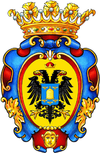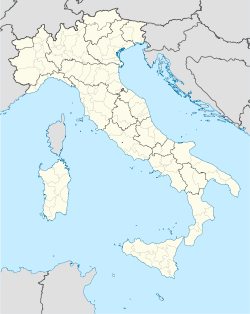- Nola
-
Nola — Comune — Comune di Nola 
Coat of armsLocation of Nola in Italy Coordinates: 40°56′N 14°32′E / 40.933°N 14.533°ECoordinates: 40°56′N 14°32′E / 40.933°N 14.533°E Country Italy Region Campania Province Naples (NA) Frazioni Boscofangone, Cappella degli Spiriti, Casamarciano, Castelcicala, Catapano, Cinquevie, De Siervo, Eremo dei Camaldoli, Martiniello, Mascello, Mascia, Pagliarone, Piazzola, Piazzolla, Pigna Spaccata, Pollastri, Polvica, Poverello, Provisiero, Sarnella Government – Mayor Geremia Biancardi Area – Total 39 km2 (15.1 sq mi) Population (1 April 2009) – Total 32,863 – Density 842.6/km2 (2,182.4/sq mi) Demonym Nolani Time zone CET (UTC+1) – Summer (DST) CEST (UTC+2) Postal code 80035 and 80037 Dialing code 081 Patron saint St. Felix Martyr Saint day November 15 Website Official website Nola is a city and comune of Campania, southern Italy, in the province of Naples, situated in the plain between Mount Vesuvius and the Apennines. It is served by the Circumvesuviana railway from Naples.
Contents
History
Nola Bronze Age settlement
Nola in Bronze Age times was the site of a settlement that has yielded evidence of the destructive power of an eruption by Mount Vesuvius between 1700 BC and 1600 BC (the Avellino eruption). Excavations revealed extensive evidence of a small village abandoned quickly by its occupants at the time of the eruption so that a wide range of pottery and other artifacts were left behind to survive with the imprint of buildings in the mud from the eruption.
Ancient era
Called Nuvlana on the most ancient coins, it was one of the oldest cities of Campania: it is said to have been founded by the Ausones. The latter were certainly in Nola about 560 BC. When it sent assistance to Naples against the Roman invasion (328 BC) it was probably occupied by the Oscans in alliance with the Samnites. In the Samnite War (311 BC) the town was taken by the Romans, while in the Second Punic War it thrice offered defiance to Hannibal (first, second, and third Battle of Nola) and on two occasions (215 and 214) it was defended by Marcellus. In the Social War it was given by treason into the hands of the Samnites, who kept it until Marius, with whom they had sided, was defeated by Sulla, who in 80 BC subjected it together with the rest of Samnium. Seven years later it was stormed by Spartacus, for which reason Augustus and Vespasian sent colonies there.
Nola, though losing much of its importance, remained a municipium with its own institutions and the use of the Oscan language. It became a Roman colony under Augustus, who died there in 14 AD. Later it became an important site of Christian pilgrimage and hospitality, after the Christian senator Paulinus relocated to the town, eventually becoming bishop.
Nola lay on the Via Popilia from Capua to Nocera Inferiore and the south, and a branch road ran from it to Abella and Avellino. Mommsen (Corp. inscr. Lat. X. 142) further states that roads must have run direct from Nola to Neapolis and Pompeii, but Kiepert's map annexed to the volume does not indicate this.
Middle Ages and Modern era
In 410 AD Nola was sacked by Alaric I, in 453 by Gaiseric and his Vandals, in 806 and again in 904 by the Saracens.
Captured by Manfred of Sicily in the 13th century, from the time of Charles I of Anjou to the mid-15th century, Nola was first a feudal possession of Guy de Monfort and then of the Orsini baronial family whose heir married Guy's oldest daughter and heir. The battle of Nola (1459) is famous for the clever stratagem by which Stephen of Anjou defeated Alfonso of Aragon.
Damaged by earthquakes in the 15th and centuries, Nola lost much of its importance. The revolution of 1820 under General Pepe began at Nola.
The sculptor Giovanni Merliano was a native of the city; and some of his works are preserved in the cathedral.
Today
Nola today is an important town close to Naples. However, most of its territory and economy are well under the control of the Camorra.
A major Camorra's activity is the illegal treatment of urban, chemical and industrial wastes in the countryside located in the region between Nola, Acerra and Marigliano. This formerly rich and green countryside is sometimes now called the "Death Triangle".
The scientific journal The Lancet Oncology published in 2004 a study by the Italian researcher Alfredo Mazza, a physiologist at the Italian CNR (Consiglio Nazionale delle Ricerche): this study revealed the terrible situation in the countryside around Marigliano and the negative impact on the people's health. He demonstrated that the deaths by cancer are much higher than average in that region compared to the European average.
Main sights and ancient findings
- The ancient Gothic cathedral (restored in 1866, and again in 1870 after the interior was destroyed by fire), with its lofty tower.
- Basilica di San Tommaso, built in the 3rd century but renovated. It has frescoes from the 9th-11th centuries depicting stories of Christ.
- Basilica of SS. Apostoli, built, according to tradition, in 95 AD. Rebuilt in 1190, it was the city's cathedral until 1593. It was decorated in Baroque style in the 1740s.
- Palazzo Orsini (built in 1470, although modified later).
- The Late-Renaissance church of San Biagio, decorated with polychrome marbles and paintings from some of the most renowned 17th century Neapolitan painters.
- The seminary in which are preserved the famous Oscan inscription known as the Cippus Abellanus (from Abella, the modern Avella) and some Latin inscriptions relating to a treaty with Nola regarding a joint temple of Hercules.
- Castle of Cicala, in the neighbourhood.
In the days of its independence Nola issued an important series of coins, and in luxury it vied with Capua. A large number of vases of Greek style were manufactured here and have been found in the neighbourhood. Their material is of pale yellow clay with shining black glaze, and they are decorated with skillfully drawn red figures. Of the ancient city, which occupied the same site as the modern town, hardly any thing is now visible, and the discoveries of the ancient street pavement have not been noted with sufficient care to enable us to recover the plan.
Numerous ruins, an amphitheatre, still recognizable, a theatre, a temple of Augustus, etc., existed in the 16th century, and were then used for building material. A few tombs of the Roman period are preserved. The neighbourhood was divided into pagi, the names of some of which are preserved to us (Pagus Agrifanus, Capriculanus, Lanitanus). Prehistoric findings are also housed in the Archaeological Museum.
There is also a monument to Giordano Bruno, who was born at Castelcicala, a locality near Nola, in 1548.
Notable people
Augustus, the first emperor of Rome, died in Nola on 19 August 14 AD.
Nola was the birthplace of Luigi Tansillo, Giovanni Merliano, whose work is well represented in the cathedral, of the physician Ambrogio Leo, and of the philosopher Nicola Antonio Stigliola. Nola is, however, best known as the hometown of the philosopher Giordano Bruno, who often referred to himself as the "Nolano," and his philosophy as the "Nolana filosofia".
Nola was the home of Saint Felix of Nola. The city was also the episcopal see of Saint Paulinus of Nola, a major theologian and writer of the late Western Roman Empire, and who is also credited with inventing the church bell (campana in Italian, taking its name from Campania). The church erected by him in honour of St. Felix in the 4th century is extant in part.
Culture
Two fairs are held in Nola, on June 14 and November 12. June 22 or the first Sunday after is devoted to a great festival ("La Festa Dei Gigli" or "The Festival of the Lillies") in honor of St. Paulinus. The festival lasts seven days, starting from the last Sunday before 22 June. In honor of St. Paulinus, eight lilies and a boat are made of wood, covered with papier-mâché from art shops of the city. The highlight of the festival is the last day, when the lilies, 25 meters high, are portative shoulder for the city's historical center, along the ritch that has been repeated more than a thousand years. Each lily is a corporation of workers in the area of Nola. The order of lilies is as follows, respecting the tradition of the old order: Greengrocer - Ortolano. Pork butcher - Salumiere. Innkeeper - Bettoliere. Baker - Panettiere. Boat - Barca. Butcher - Beccaio. Shoemaker - Calzolaio. Smith - Fabbro. Dressmaker - Sarto. For seven days, the city relives its full historical and folklore of his faith to St. Paul's. Throughout the week each lily organizes evenings where you can dance, drink and have fun. The festival of 2010 was nominated along with other similar festivals, on the Italian territory, to become a Unesco world heritage site.
See also
- Vulcano Buono
- Triangle of death (Italy)
Sources
 This article incorporates text from a publication now in the public domain: Chisholm, Hugh, ed (1911). Encyclopædia Britannica (11th ed.). Cambridge University Press.
This article incorporates text from a publication now in the public domain: Chisholm, Hugh, ed (1911). Encyclopædia Britannica (11th ed.). Cambridge University Press. This article incorporates text from a publication now in the public domain: Herbermann, Charles, ed (1913). Catholic Encyclopedia. Robert Appleton Company.
This article incorporates text from a publication now in the public domain: Herbermann, Charles, ed (1913). Catholic Encyclopedia. Robert Appleton Company.References
External links
- Relazione della Commissione Parlamentare, a relation about the camorra in Campania (October 2000) (Italian)
- "The Death Triangle", published on the Italian newspaper Repubblica.it (2004) (Italian)
- Website of the festival in honor of Paulinus
- Information site dedicated to the Feast of the Lilies
- Information portal of Nola and the Feastival of the Lilies
- One of the "fishing boats" of the Feastival of the Lilies
- http://www.comune.nola.na.it/
Categories:- Cities and towns in Campania
- Communes of the Province of Naples
- Roman sites of Campania
- History of the Camorra in Italy
- Osci
Wikimedia Foundation. 2010.


